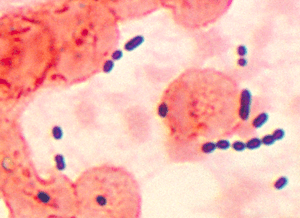Enterococcus
| Enterococcus | |
|---|---|
 | |
| Enterococcus sp. infection in pulmonary tissue | |
| Scientific classification | |
| Kingdom: | Bacteria |
| Division: | Firmicutes |
| Class: | Bacilli |
| Order: | Lactobacillales |
| Family: | Enterococcaceae |
| Genus: | Enterococcus (ex Thiercelin & Jouhaud 1903) Schleifer & Kilpper-Bälz 1984 |
| Species[1] | |
| |
Enterococcus is a large genus of lactic acid bacteria of the phylum Firmicutes. Enterococci are Gram-positive cocci that often occur in pairs (diplococci) or short chains, and are difficult to distinguish from streptococci on physical characteristics alone.[3] Two species are common commensal organisms in the intestines of humans: E. faecalis (90–95%) and E. faecium (5–10%). Rare clusters of infections occur with other species, including E. casseliflavus, E. gallinarum, and E. raffinosus.[3]
Physiology and classification
Enterococci are facultative anaerobic organisms, i.e., they are capable of cellular respiration in both oxygen-rich and oxygen-poor environments.[4] Though they are not capable of forming spores, enterococci are tolerant of a wide range of environmental conditions: extreme temperature (10–45 °C), pH (4.5–10.0), and high sodium chloride concentrations.[5]
Enterococci typically exhibit gamma-hemolysis on sheep's blood agar.[6]
History
Members of the genus Enterococcus (from Greek έντερο, éntero, "intestine" and κοκκος, coccos, "granule") were classified as group D Streptococcus until 1984, when genomic DNA analysis indicated a separate genus classification would be appropriate.[7]
Pathology
Important clinical infections caused by Enterococcus include urinary tract infections, bacteremia, bacterial endocarditis, diverticulitis, and meningitis.[5][6] Sensitive strains of these bacteria can be treated with ampicillin, penicillin and vancomycin.[8] Urinary tract infections can be treated specifically with nitrofurantoin, even in cases of vancomycin resistance.[9]
From a medical standpoint, an important feature of this genus is the high level of intrinsic antibiotic resistance. Some enterococci are intrinsically resistant to β-lactam-based antibiotics (penicillins, cephalosporins, carbapenems), as well as many aminoglycosides.[6] In the last two decades, particularly virulent strains of Enterococcus that are resistant to vancomycin (vancomycin-resistant Enterococcus, or VRE) have emerged in nosocomial infections of hospitalized patients, especially in the US.[5] Other developed countries, such as the UK, have been spared this epidemic, and, in 2005, Singapore managed to halt an epidemic of VRE.[10] VRE may be treated with quinupristin/dalfopristin (Synercid) with response rates around 70%.[11] Tigecycline has also been shown to have antienterococcal activity, as has rifampicin.
Enterococcal meningitis is a rare complication of neurosurgery. It often requires treatment with intravenous or intrathecal vancomycin, yet it is debatable as to whether its use has any impact on outcome: the removal of any neurological devices is a crucial part of the management of these infections.[12] New epidemiological evidence has shown that enterococci are major infectious agent in chronic bacterial prostatitis. Enterococci are able to form biofilm in the prostate gland, making their eradication difficult.
Water quality
In bodies of water, the acceptable level of contamination is very low; for example in the state of Hawaii, and most of the United States, the limit for water off its beaches is a five-week geometric mean of 35 colony-forming units per 100 ml of water, above which the state may post warnings to stay out of the ocean.[13] In 2004, Enterococci sp. took the place of fecal coliforms as the new USA federal standard for water quality at public saltwater beaches and E. coli at freshwater beaches.[14] It is believed to provide a higher correlation than fecal coliform with many of the human pathogens often found in city sewage.[15]
References
- ↑ LPSN entry for Enterococcus
- ↑ LPSN bacterio.net
- 1 2 Gilmore MS; et al., eds. (2002). The Enterococci: Pathogenesis, Molecular Biology, and Antibiotic Resistance. Washington, D.C.: ASM Press. ISBN 978-1-55581-234-8.
- ↑ Fischetti VA, Novick RP, Ferretti JJ, Portnoy DA, Rood JI, eds. (2000). Gram-Positive Pathogens. ASM Press. ISBN 1-55581-166-3.
- 1 2 3 Fisher K, Phillips C (June 2009). "The ecology, epidemiology and virulence of Enterococcus". Microbiology. 155 (Pt 6): 1749–57. doi:10.1099/mic.0.026385-0. PMID 19383684.
- 1 2 3 Ryan KJ, Ray CG, eds. (2004). Sherris Medical Microbiology (4th ed.). McGraw Hill. pp. 294–5. ISBN 0-8385-8529-9.
- ↑ Schleifer KH, Kilpper-Balz R (1984). "Transfer of Streptococcus faecalis and Streptococcus faecium to the genus Enterococcus nom. rev. as Enterococcus faecalis comb. nov. and Enterococcus faecium comb. nov.". Int. J. Sys. Bacteriol. 34: 31–34. doi:10.1099/00207713-34-1-31.
- ↑ Pelletier LL Jr. (1996). "Microbiology of the Circulatory System". In Baron S; et al. Baron's Medical Microbiology (4th ed.). Univ of Texas Medical Branch. ISBN 0-9631172-1-1.
- ↑ Zhanel GG, Hoban DJ, Karlowsky JA (January 2001). "Nitrofurantoin is active against vancomycin-resistant enterococci". Antimicrob. Agents Chemother. 45 (1): 324–6. doi:10.1128/AAC.45.1.324-326.2001. PMC 90284
 . PMID 11120989.
. PMID 11120989. - ↑ Kurup, Asok; Chlebicki, M.P.; Ling, M.L.; Koh, T.H.; Tan, K.Y.; Lee, L.C.; Howe, K.B.M. (April 2008). "Control of a hospital-wide vancomycin-resistant Enterococci outbreak". American Journal of Infection Control. 36 (3): 206–211. doi:10.1016/j.ajic.2007.06.005. Retrieved 26 November 2014.
- ↑ Tünger A, Aydemir S, Uluer S, Cilli F (2004). "In vitro activity of linezolid & quinupristin/dalfopristin against Gram-positive cocci". Indian J Med Res. 120 (6): 546–52. PMID 15654141.
- ↑ Guardado R; Asensi V; Torres JM; et al. (2006). "Post-surgical enterococcal meningitis: clinical and epidemiological study of 20 cases". Scand. J. Infect. Dis. 38 (8): 584–8. doi:10.1080/00365540600606416. PMID 16857599.
- ↑ "Clean Water Branch" (PDF). Hawaii State Department of Health. Retrieved 2012-05-18.
- ↑ "Water Quality Standards for Coastal and Great Lakes Recreation Waters; Final Rule". Federal Register. 69 (220): 67218–67243. 16 November 2004. Retrieved 26 November 2014.
- ↑ Jin G, Jeng HW, Bradford H, Englande AJ (2004). "Comparison of E. coli, enterococci, and fecal coliform as indicators for brackish water quality assessment". Water Environ. Res. 76 (3): 245–55. doi:10.2175/106143004X141807. PMID 15338696.
| Enterococcus | |
|---|---|
| Classification and external resources | |
| ICD-9-CM | 041.04 |